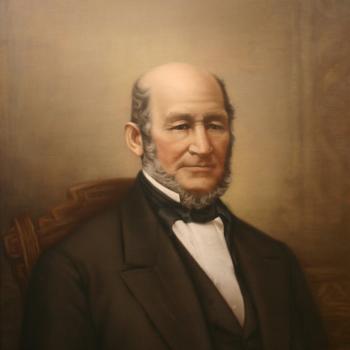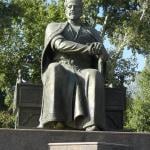 Oxford University Press recently published The Jewish Annotated New Testament edited by A-J Levine (Vanderbilt) and Marc Zvi Brettler (Brandeis). As you might suspect, the purpose of this volume is the provide scholarship on the Jewish contexts in which the NT and the community of Jesus followers arose. The book is made up of two parts: the first part is the text of the New Testament (NRSV) with introductory and study notes by Jewish scholars. The second part of the book is a mini-dictionary with a variety of entries on aspects of early Judaism and the Jewish background and contexts of the NT by the same scholars.
Oxford University Press recently published The Jewish Annotated New Testament edited by A-J Levine (Vanderbilt) and Marc Zvi Brettler (Brandeis). As you might suspect, the purpose of this volume is the provide scholarship on the Jewish contexts in which the NT and the community of Jesus followers arose. The book is made up of two parts: the first part is the text of the New Testament (NRSV) with introductory and study notes by Jewish scholars. The second part of the book is a mini-dictionary with a variety of entries on aspects of early Judaism and the Jewish background and contexts of the NT by the same scholars.
What first attracted me to this book was the short dictionary article in the second part by Levine called “Bearing False Witness: Common Errors Made About Early Judaism.” Here Levine exposes misunderstandings and common mistakes made, even by reputable NT scholars, when it comes to perspectives on early Judaism. Here is her “hit list.”
Myth #1: the Jewish law of Jesus’ time was impossible to follow (Acts 15:10). She argues, “In actuality, Jews, then and now, did not find Torah observance any more burdensome than citizens in most countries find their country’s laws today.” She also points to Jesus’ own law-obedience.
Myth #2: Jews follow Torah in order to earn God’s love or a place in heaven. This is the mistake of viewing Judaism as a merit-based religion. She points to the election of God, which was a gift in the eyes of early Jews. She admits some early Jewish texts may have taken a stronger “merits” perspective, but she urges that the majority of Jews did not think like this.
Myth #3: Purity laws were burdensome and unjust. She exposes a number of misconceptions about Jewish purity. For example, Levine points out that, in the situation of Jesus touching the woman with a flow of blood (and accepting contact with a person who is impure), this does not show that Jesus is loving, while most Jews are only concerned with purity. She explains that impurity based on menstruation could not be passed on by hand. I (Nijay) agree that OT purity laws were not burdensome and unjust. However, it could have been that some groups in society intensified the laws and extended them in unjust ways.
Myth #4: early Judaism was cruel towards women. Levine doesn’t think we should view Jesus as a radical egalitarian either. He did not have any women as members of the twelve. She admits that certain parts of Rabbinic texts reflect on women negatively, but we have much reason to believe women were treated quite well in early Judaism.
Myth #5: Jesus forbids divorce because Jewish men sent away their wives “for the flimsiest of reasons.” Levine points out that some strands of Jewish teaching held to very strict standards for divorce.
Myth #6: Jesus ministers to the marginal and outcast. Levine asks: “cast out by whom? Cast out from what?” Sinners and taxcollectors, she argues, “are people who violate the welfare of the community and who have deliberately removed themselves from the common good” (503). Even gentiles are not marginalized by Judaism. The are welcome in the synagogues and temple (to a certain extent).
Myth #7: All Jews wanted a militant messiah. She makes it clear that there was no universal understanding or expectation of the Messiah. Some expected a priest, others a shepherd. She also notes that Jesus was not exactly the pacifist – he commanded his disciples to carry weapons (Luke 22:36-38). I think Levine is wise to express caution, but she downplays the overwhelming number of texts that reveal expectations of a warrior messiah.
Myth #8: Jesus invented the idea of an intimate heavenly “Father.” OT, early Jewish, and Rabbinic texts all employ the title of Father for God sometimes, Levine reminds us.
Myth #9: Jesus condemned the temple institution. Jesus never accuses the temple institution of corruption. She argues, “The vast majority of the Jewish people loved the Temple, visited it on pilgrimage festivals, protected it from Roman profanation, and mourned its destruction” (p. 504).
Myth #10: Early Judaims was narrow, clannish, and exclusivistic and Jesus invented universalism. She admits the Qumranists were sectarian, but other groups were more open and embracing.
Overall, Levine offers much food for thought. Her best points are #1, #2, #6, #9, and #10. I take a bit of an issue with #7 (militant messiah). Yes, true, views of the Messiah were varied. But there are SO many texts that anticipate a warrior that I think we can say that if there was a wider (though not universal) trend, it was the hope of a militant messiah. Even the DSS, which expect a priest like Aaron, still see the Messiah engaging in serious conflict. I think it would be nice to have a longer version of her responses, especially to the matter of Jesus and women (#4) and his relationship with outcasts (#6).
There are many great articles in the second part by scholars like Martin Goodman, Shaye Cohen, and Mark Nanos. I was more disappointed with the NRSV study notes. Most of the time they were too brief. Other times, they had nothing to do with Judaism – they were the kind of notes you would find in any academic study Bible (they just happen to be written by a Jewish scholar). Finally, the biggest concern I had with the book was the casual way that some authors dismissed the NT writers’ views as biased or historically inaccurate. While they are trying to correct anti-semitic views, do they not recognize that they are Jewish scholars correcting (mostly?) Jewish NT writers? For example, one writer declared that Mark was flat-out wrong in his interpretation of Jesus’ words in Mark 7:19 – “Thus he declared all foods clean.” It is one thing if you find Mark’s words perplexing, it is another to accuse him of distortion, sloppiness, or stupidity. I had hoped that the corrective and clarifying aspects of this volume would be more gracious.
That having been said, I am very excited to have this book and especially to read the essays in the second part – most of which are written by leading experts in early Judaism. As for the study notes, I hope to dip into Mark Nanos’ notes on Romans, Shaye Cohen’s on Galatians, and Pamela Eisenbaum’s on Hebrews. Also, the price (Amazon: $23) is not bad for a book from Oxford!















